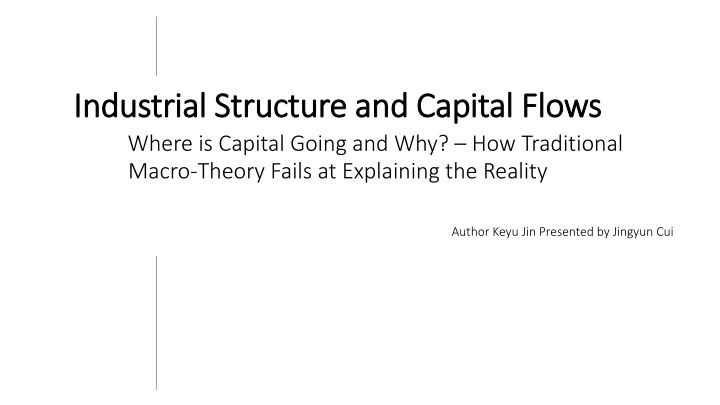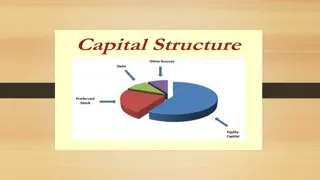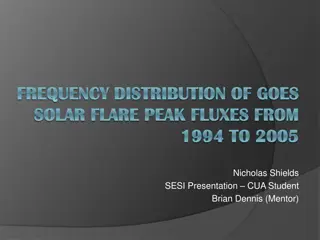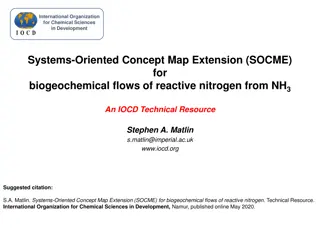
Industrial Structure and Capital Flows: Where Capital Goes and Why
This presentation delves into the dynamics of capital flows, highlighting the disconnect between traditional macroeconomic theories and real-world observations. Keyu Jin's analysis uncovers the reasons behind capital movements, discussing the influence of labour forces, productivity, and market integration.
Download Presentation

Please find below an Image/Link to download the presentation.
The content on the website is provided AS IS for your information and personal use only. It may not be sold, licensed, or shared on other websites without obtaining consent from the author. If you encounter any issues during the download, it is possible that the publisher has removed the file from their server.
You are allowed to download the files provided on this website for personal or commercial use, subject to the condition that they are used lawfully. All files are the property of their respective owners.
The content on the website is provided AS IS for your information and personal use only. It may not be sold, licensed, or shared on other websites without obtaining consent from the author.
E N D
Presentation Transcript
Industrial Structure and Capital Flows Industrial Structure and Capital Flows Where is Capital Going and Why? How Traditional Macro-Theory Fails at Explaining the Reality Author Keyu Jin Presented by Jingyun Cui
Overview What Is This PowerPoint All About? A Typical Theory Building Process Introduction Background Background What is happening Why is this happening How Is Jin Solving These Problems Framework Analysis Key Factors in the Model The Composition Effect Quantitative Analysis Summary Overview Publish! Get the conclusion and send it to some journal editors Check a bit Do some analysis to double check the new theory Do it! Now it s the part to actually save this world How to fix? Think about how to fix the problem Why? Find out what is causing the problem Wait What? Something is not explained by the current theory Author did quant analysis and found some empirical material to test her theory
Overview Before We Start Some Helpful Macroeconomics Concepts Current Account and Balance of Payments Overview Background What is happening Why is this happening How Is Jin Solving These Problems Framework Analysis Key Factors in the Model The Composition Effect Quantitative Analysis Summary Balance of payments measures all of a country s transactions with its partner. Current account is one of the two components of a country s balance of payments, the other being the capital account. Current account consists of the balance of trade, net primary income (net earnings on foreign investments). ???= ??? ??????? ?????? ??? ??????? ?????? 1 International Capital Flow Convergence effect, also known as the catch-up effect), is the idea that developed countries face diminishing return to capital so that capital will flow from these countries to developing countries. Neoclassical growth theory predicts an increase in the labor force/productivity will leads to a net capital inflow.
Background What Is Happening Right Now? Mismatch Between Traditional Theory and Reality Introduction Background Background What is happening Why is this happening How Is Jin Solving These Problems Framework Analysis Key Factors in the Model The Composition Effect Quantitative Analysis Summary Overview Classical Macro Theory Reality Increase in the labor-force or labor productivity in a country induce a net capital inflow Trade and financial integration and rapid labor force and labor productivity growth in emerging markets lead to a net capital outflow for these markets Capital flow from developed countries to developing countries This paper tries to fix this problem! Capital flows from emerging markets to capital-intensive markets Convergence effect, which channels capital toward where the effective capital- labor ratio is lower Composition effect, which offsets the Convergence effect
Background Why Is This Happening? (1/2) Where Neoclassical Theory Fails Introduction Background Background What is happening Why is this happening How Is Jin Solving These Problems Framework Analysis Key Factors in the Model The Composition Effect Quantitative Analysis Summary Overview Unaddressed Composition Effect Inaccurate Standard Open-economy Models Currently, models do not examine the impact of convergence effect and composition effect separately. Such models cannot explain the fact that capital are flowing from emerging markets to economies that become more specialized in capital-intensive sectors. The standard models are the one-good or two-good stochastic growth models of large open economies. These models do not account for factor-proportions trade. Also, their overlapping generations structure are not essential. Untenable Underlying Assumption Problematic theories we are using right now Standard open-economy models predict net capital inflow into developing countries, which is the opposite of what is happening. This is caused by the fact that they assume that countries cannot engage in intra-temporal commodity trade but only in intertemporal trade. However, large scale forces can alter a country s structure of trade. Missing Influence of Macro Dynamics The conventional analyses of international macroeconomic dynamics on the structure of trade as well as the aggregate feedback effects of trade pattern while their interaction can be crucial in determining the global allocation of capital .
Background Why Is This Happening? (2/2) Where Neoclassical Theory Fails Introduction Background Background What is happening Why is this happening How Is Jin Solving These Problems Framework Analysis Key Factors in the Model The Composition Effect Quantitative Analysis Summary Overview Unaddressed Composition Effect Inaccurate Standard Open-economy Models Currently, models do not examine the impact of convergence effect and composition effect separately. Such models cannot explain the fact that capital are flowing from emerging markets to economies that become more specialized in capital-intensive sectors. The standard models are the one-good or two-good stochastic growth models of large open economies. These models do not account for factor-proportions trade. Also, their overlapping generations structure are not essential. Untenable Underlying Assumption Problematic theories we are using right now Standard open-economy models predict net capital inflow into developing countries, which is the opposite of what is happening. This is caused by the fact that they assume that countries cannot engage in intra-temporal commodity trade but only in intertemporal trade. However, large scale forces can alter a country s structure of trade. Missing Influence of Macro Dynamics The conventional analyses of international macroeconomic dynamics on the structure of trade as well as the aggregate feedback effects of trade pattern while their interaction can be crucial in determining the global allocation of capital .
Background How Is Jin Solving These Problems? (1/2) Upgrading the model Introduction Background Background What is happening Why is this happening How Is Jin Solving These Problems Framework Analysis Key Factors in the Model The Composition Effect Quantitative Analysis Summary Overview How is Jin Addressing this Problem Inaccurate model Developing a stochastic two-country overlapping generations model with production and capital accumulation. Multiple tradable sectors that differ in factor intensity are incorporated to capture factor-proportions-based trade, and financial capital is allowed to flow across borders. Isolate the convergence effect and the composition effect. Analytical tractability. Closed-form solutions can be found. The standard open-economy are the one-good or two- good stochastic growth models of large open economies that do not address factor-proportions trade. Current models cannot address the impact of the composition effect.
Background How Is Jin Solving These Problems? (2/2) Addressing the Composition Effect Introduction Background Background What is happening Why is this happening How Is Jin Solving These Problems Framework Analysis Key Factors in the Model The Composition Effect Quantitative Analysis Summary Overview How is Jin Addressing this Problem Missing Composition Effect Convergence effect and composition effect coexist. In the integrated framework it s possible to isolate the convergence effect and the composition effect to examine their disparate impact on capital flows. In the special case, in which the most labor- intensive sector uses only labor as an input to production, isolates the composition effect. Additional assumption is needed to provide closed-form solution under two- country stochastic growth model. The convergence effect and the composition effect co-exist and their combined force determine the tide of capital flow. Current theory focuses only on the standard convergence effect.
FOREIGN Framework The Model Description Set up the imaginary world Introduction Background Background What is happening Why is this happening How Is Jin Solving These Problems Framework Analysis Key Factors in the Model The Composition Effect Quantitative Analysis Summary Overview There are two countries, Home (h) and Foreign (f) Labor input consists only of domestic labor, and IGP* firms are subject to country-specific productivity HOME Each country has an overlapping generations economy with young and old consumers. Young consumer supplies one unit of labor while the old only consume 1 Preferences and production technologies are assumed to have the same structure and parameter value Earth-500R Each country uses identical technology to produce intermediate goods I, which are traded freely and costlessly 4 Intermediate goods are combined to produce a composite good that is used for consumption and investment *IGP firms: Intermediate- goods-producing firm
Analysis Key Factors in the Model (1/13) Part I Production Technologies Introduction Background Background What is happening Why is this happening How Is Jin Solving These Problems Framework Analysis Key Factors in the Model The Composition Effect Quantitative Analysis Summary Overview Production Technologies Gross production of intermediate good ? in country ?: ? ? ?1 ? ?= ??? ???? ??? ?? Where K represents capital, A represents labor productivity, and ? is the labor population. can be seen as capital intensity measurement. There is also the composite good for Con. and Inv., Consumers ? 1 ? 1 ? 1 ????,? ?= ? ??? ?? Market Clearing ?=1 Where x donates the amount of good ? used for investment in that sector ? of country ?; also, summation of ? equals to 1, and ? is always greater than 0. Equilibrium
Analysis Key Factors in the Model (2/13) Part I Production Technologies Introduction Background Background What is happening Why is this happening How Is Jin Solving These Problems Framework Analysis Key Factors in the Model The Composition Effect Quantitative Analysis Summary Overview Because all goods can be traded freely, the law of one price holds for all intermediate goods, and their prices can be donated as ???. Since preferences are symmetric across countries, its associated investment price index is Production Technologies 1 ? 1 ? 1 ? Consumers ??= ????? ?=1 Which is normalized to 1 for simplicity. Then, we have the capital used in producing goods ? in country ? augmented by ??? is given by ??,?+1 = ? ??? and linearly homogeneous in ? & ? ? and ??? ?,??? ?. The law of motion for ? ?, where ?() is nondecreasing Market Clearing ? ? ?1 ? ? ? ??,?+1 = ? ??? ??? Where ?~ 0,1 & ? is greater than 0. Equilibrium
Analysis Key Factors in the Model (3/13) Part I Production Technologies Introduction Background Background What is happening Why is this happening How Is Jin Solving These Problems Framework Analysis Key Factors in the Model The Composition Effect Quantitative Analysis Summary Overview Comparing to the standard capital accumulation equation with adjustment costs, Production Technologies 2 ? ??? ??? ? ? ? ?+ ??? ? ??,?+1 = 1 ? ??? ? ? ??? 2 Where ? is depreciation rate. Our log-linear model and standard model are equivalent up to the second order. Now, let ??? the composite good, of acquiring one unit of capital at the end of the current period to be carried into the next period; it is also the additional ??? unit. Thus, 1 ? Consumers ? be the price of capital. It is the price, in term of Market Clearing ? needed to augment ??,?+1 ? by one ? ? ??? ??? =??? 1 ?= ???,?+1 ? ??? & ??? ? ?? ? Equilibrium
Analysis Key Factors in the Model (4/13) Part I Production Technologies Introduction Background Background What is happening Why is this happening How Is Jin Solving These Problems Framework Analysis Key Factors in the Model The Composition Effect Quantitative Analysis Summary Overview Wage rate per unit of labor is given by, Production Technologies ? 1 ??????? ??? ?= ??? ? ?= ?? ? because labor is mobile between sectors And ??? within each country. Ultimately, we also want to know the rate of return to capital. By breaking down return into rental earned, which is ??????? process, which is the marginal contribution of capital in augmenting capital stock for use in the next period times relative price of capital, ??+1 ?? ??????? ??? Consumers ?/??? ?, and rental earned in the capital adjustment Market Clearing ? ????. Dividing return by price, ? ? +(1 ?)??? ???? ??,? 1 ? ? Equilibrium ?= ???
Analysis Key Factors in the Model (5/13) Part II Consumers Introduction Background Background What is happening Why is this happening How Is Jin Solving These Problems Framework Analysis Key Factors in the Model The Composition Effect Quantitative Analysis Summary Overview Production Technologies Technologies Production j evolves according to, ???? Consumers Nt ?= ???? 1 ? ? + ??,? Where ? is simply an independent random variable. For young consumer who earns wage ?? , and uses his wage both on consumption ?? ?, , and on purchasing capital, ? Consumers ?, = ?? ???,?+1 ,? ?? ??? ?= ,? ?=1 Assume consumers consume all resources when old. At ? + 1, their consumption, which is financed entirely by capital, is ? Market Clearing ? ???,?1 ,? 0, = ??+1 ??,?+1 ??? ?= ,? ?=1 Equilibrium
Analysis Key Factors in the Model (6/13) Part II Consumers Introduction Background Background What is happening Why is this happening How Is Jin Solving These Problems Framework Analysis Key Factors in the Model The Composition Effect Quantitative Analysis Summary Overview Production Technologies Technologies Production The lifetime utility of consumption that a Home consumer born in the beginning of ?maximizes is, ?, 1 ? 1 ? ?, ?? ??+1 1 ? ?,? & ??+1 ??= + ??? 1 ? ?,? denote Consumers Where ? denotes discount factor. ?? consumption of the young and the old consumer at each time period. The aggregate consumption index in ? at ? is, ? ? ? 1 ? 1 ? 1 ???? Market Clearing ?= ? ?? ?? ?=1 ? represents consumption demand. Consumption Where ??? price index is as same as the investment price index ??. Equilibrium
Analysis Key Factors in the Model (7/13) Part III Market Clearing Introduction Background Background What is happening Why is this happening How Is Jin Solving These Problems Framework Analysis Key Factors in the Model The Composition Effect Quantitative Analysis Summary Overview The intermediate goods market clear when global demand equals supply. Let ??? Production Technologies Technologies Production ? denotes output, clearing requires ? ?= ?+ ? ??? ??? ???,? ?= ,? ??? ?= ,? = ????? ?=1 ?= ????? ?= ?=1 ?& ???,? into output equation, we have, ? & ???,? ? ? ???? Where ??? Let ?? ??? Consumers Consumers ? denotes aggregate investment, replacing ???? ? 1 ? ? ??? ??? ?? ?? ??? ??? = Market Clearing ? Which shows the relative price of any two goods falls with respect to an increase in the relative output of the two goods with an elasticity 1 ?. When ? = 1, output changes are offset by price changes so that nominal value of output remain unchanged Equilibrium
Analysis Key Factors in the Model (8/13) Part III Market Clearing Introduction Background Background What is happening Why is this happening How Is Jin Solving These Problems Framework Analysis Key Factors in the Model The Composition Effect Quantitative Analysis Summary Overview Production Technologies Technologies Production Next, domestic labor markets clear when, ? ?= ?? ? ??? ?=1 Because of world resource constraint, we have the total amount of final goods in the world, ?? Where ?? Lastly, GDP can be defined as total consumption and market value of capital stock, ? Consumers Consumers ?= ?? ?,?+ ?? 1 ?+ ?? ?? ? ?= ??? ?= ??? ??? ? ?,? & ?? ?. Market Clearing ?+1 ? ?= ? ???? ?????? ?? ? ?=1 Equilibrium
Analysis Key Factors in the Model (9/13) Key assumption needed for a semi-closed form solution Introduction Background Background What is happening Why is this happening How Is Jin Solving These Problems Framework Analysis Key Factors in the Model The Composition Effect Quantitative Analysis Summary Overview All assumptions are important for analytical convenience, and will be relaxed later during the quantitative analysis section. Assumption 1 Unitary elasticity of substitution of intermediate goods ( = 1). Assumption 2 Consumers have logarithmic preferences ( = 1). Assumption 3 j The capital-adjustment technology is log-linear, as in equation Ki,t+1 . Let s get back!
Analysis Key Factors in the Model (10/13) Part IV Equilibrium Introduction Background Background What is happening Why is this happening How Is Jin Solving These Problems Framework Analysis Key Factors in the Model The Composition Effect Quantitative Analysis Summary Overview Assuming logarithmic utility, the optimal consumption of a young consumer in ? is a constant fraction of present value of lifetime resources, which is simply the wage earned by the young. The optimal consumption is therefore, Production Technologies Technologies Technologies Production Production 1 ?.?= ? ?? 1 + ? ?? Consumers Consumers Consumers ?,?= ?? ??? ?,? be the aggregate consumption of the Let ?? young cohort. Global consumption ?? of world labor income ?? substitution, ?? world output. Then, the global investment-output ratio is a constant, ?? ?? Where ? = 1+? ?,? is a constant fraction ?. With a unitary elasticity of ? is a constant share ??= ???(1 ??) of Market Clearing ? ?= ??? Equilibrium ??
Analysis Key Factors in the Model (11/13) Part IV Equilibrium Introduction Background Background What is happening Why is this happening How Is Jin Solving These Problems Framework Analysis Key Factors in the Model The Composition Effect Quantitative Analysis Summary Overview Then, we represent investment in each sector of each country by, ??? Where ? & ? represent industry-level and country-level investment share of the global investment. LEMMA 1: The share of global investment allocated to industry is a constant where, Production Technologies Technologies Technologies Production Production ? ?= ?????? ??? Consumers Consumers Consumers ? ??= (????)/( ????) ? ?=1 The greater ?? & ??, the greater investment in industry level. The country-share of global investment in any industry is very important in determining the evolution of a country s aggregate capital stock and aggregate investment, Market Clearing ? ????(??,?+?+1 ??,?+?+1 ?= (1 ?) ??? ) ? Equilibrium ?=1
Analysis Key Factors in the Model (12/13) Part IV Equilibrium Introduction Background Background What is happening Why is this happening How Is Jin Solving These Problems Framework Analysis Key Factors in the Model The Composition Effect Quantitative Analysis Summary Overview ?= Country s share of global investment can be written as ?? ?? ? Production Technologies Technologies Technologies ?, where, ??? Production Production ????? ?= ?= ? ?? ????? ??? ?? ?=1 ?=1 Where ?? is the weighted-average capital share. Investment is not only associated with the size of its expected relative production, captured by ??? production. The higher ?? is put on the expected share of future capital-intensive-goods production, the less weight is put on its expected share of labor-intensive-goods production. By contrast, in the one-sector model, ?? present-discounted value of its share of the only good produced globally. A positive, permanent, technology or lobar shock in Foreign, which effectively increases Foreign s share of global production, would cause a large drop in Home s share of investment. Consumers Consumers Consumers ?, but also with its composition of Market Clearing ?is country s expected Equilibrium
Analysis Key Factors in the Model (13/13) Part IV Equilibrium Introduction Background Background What is happening Why is this happening How Is Jin Solving These Problems Framework Analysis Key Factors in the Model The Composition Effect Quantitative Analysis Summary Overview The total net foreign assets of Home, donates as ???? is the value of Home s claims on foreigner less the value of foreigner s claim on Home, ? ???,?+1 ?=1 Where S is aggregate saving of the young ?? Production Technologies Technologies Technologies Production Production ? ,??? ?, ?? ?= ?? ?, ?? ??+1 ??,?+1 = ??? ??? ?=1 ? Consumers Consumers Consumers ?,?= ?. 1+? ?? , is The current account of Home in period t, denoted as ??? ??? Finally, these equation will yield for solution. 1) ??? 2) ??= (????)/( ?=1 ????) ? = ???? ???? 1 ? ?= ?????? ??? Market Clearing ? ? ??,?+?+1 ??,?+?+1 ?= 1 ? ?=1 ???? 3) ??? ? Equilibrium ? 1 ? j j j 4) Ki,t+1 = a Iit Kit
Analysis The Composition Effect (1/3) Additional Assumption needed Introduction Background Background What is happening Why is this happening How Is Jin Solving These Problems Framework Analysis Key Factors in the Model The Composition Effect Quantitative Analysis Summary Overview Assumption 1 All assumptions are important for analytical convenience, and will be relaxed later during the quantitative analysis section. Unitary elasticity of substitution of intermediate goods ( = 1). Assumption 2 Consumers have logarithmic preferences ( = 1). Assumption 3 j The capital-adjustment technology is log-linear, as in equation Ki,t+1 . Assumption 4 The most labor-intensive sector uses only labor as an input and no capital in the production technology, i.e., 1 = 0. Let s get back!
Analysis The Composition Effect (2/3) Interaction between output and investment Introduction Background Background What is happening Why is this happening How Is Jin Solving These Problems Framework Analysis Key Factors in the Model The Composition Effect Quantitative Analysis Summary Overview Proposition 1: With Assumption 1-4, the share of Home s investment in any industry ?,???, is a constant and is equal to its initial share of world capital stock in that sector. ???=??0 ??0 Combining with ?? ?? ? ? ? ? ? ?= ??? & ??? ??,?+?+1 ??,?+?+1 ?= 1 ? ?=1 ???? , we have, ? ? ?= ?????? ?? ????0 ?=1 This means increase in ? caused by a positive labor force/productivity shock will also leads to an increase in ?, in such a way that more investment is allocated to the country that has a higher initial, weighted-average capital share.
Analysis The Composition Effect (3/3) Other solutions Introduction Background Background What is happening Why is this happening How Is Jin Solving These Problems Framework Analysis Key Factors in the Model The Composition Effect Quantitative Analysis Summary Overview Another way to understand allocation of saving across countries is by analyzing a country s supply of saving relative to tis demand for investment. Author shows that because the young who work and earn labor income are the savers in the economy, a country s supply of savings derives from its capacity to generate labor income. That said, country s saving to GDP ration at anytime depends on its relative capital-labor ratio. Since, ?? ???? ?? Then, ?? ???? ?? And, ?? ???? ?? ? 1 ?= ? ?? ??+? 1 ? + 1 1 + ? ?,? ?/(1 + ?) ??+? 1 ? ?= ? ?? + 1 1 + ? ?/? ??/(1 + ?) ??+? 1 ? 1 + ? ?? ?= ? ?? + 1
Analysis - Quantitative Analysis Extending into Multi-period OLG setting Introduction Background Background What is happening Why is this happening How Is Jin Solving These Problems Framework Analysis Key Factors in the Model The Composition Effect Quantitative Analysis Summary Overview Apply to two global events Two-period OLG Framework Multi- period OLG Framework Here author extends the analytical two-period OLG framework to a multi-period OLG setting, allowing for an additional nontradable sector. And then use that framework to examine two important global events in the past. She examines what the almost-simultaneous advent of emerging economies implies for international capital flows. Also, increasing labor force in emerging market will have its impact on the current account with the help of factor-proportions trade.
Summary and Conclusion Introduction Background Background What is happening Why is this happening How Is Jin Solving These Problems Framework Analysis Key Factors in the Model The Composition Effect Quantitative Analysis Summary Overview New Framework Composition Effect Author developed a general- equilibrium framework that integrates a factor- proportions paradigm of trade and financial capital flows, allowing for their interplay This paper take into account the composition effect, which coexist with the standard, classical convergence effect. Real-world Events There is a mismatch between what neo-classical macroeconomic theory predicts and what is really happening
Summary and Conclusion Other Materials Introduction Background Background What is happening Why is this happening How Is Jin Solving These Problems Framework Analysis Key Factors in the Model The Composition Effect Quantitative Analysis Summary Overview Productivity Growth and Capital Flows: The Dynamics of Reforms By Francisco J. Buera and Yongseok Shin (2011) Standard economic theory predicts that capital should flow into countries experiencing a sustained increase in total factor productivity (TFP). The evidence from developing countries over the last three decades contradicts this prediction. Patterns of International Capital Flows and Productivity Growth: New Evidence By Margaux MacDonald (2015) Recent evidence from developing and emerging economies shows a negative correlation between growth and net capital inflows, a contradiction to neoclassical growth theory.






















